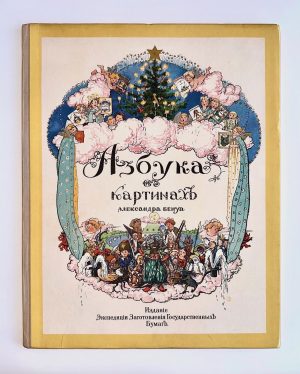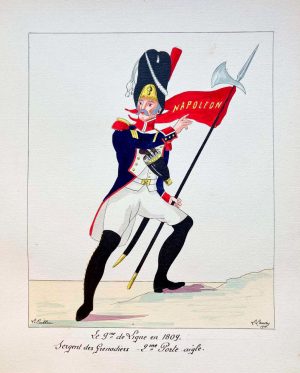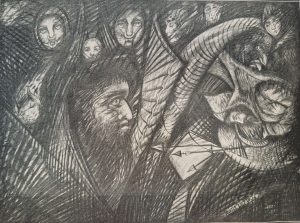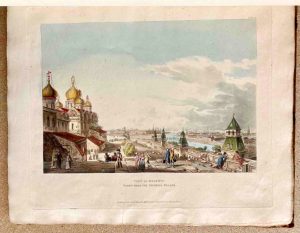Our Notes & References
One of the most striking and elaborate of all ABCs and possibly the most impressive in Russian.
An exceptional example, with the beautiful publisher’s pictorial covers in superbly fresh condition.
Benois, a famous Russian artist and art historian, co-founder of the fertile art movement Mir Iskusstva, began working on his ABC in 1903, when his son Kolya was almost 2 years old. He chose the luxurious way: the quarto format, a page for each letter, richly coloured chromolithographs, and the State Press, a prestigious publishing house, which produced Bilibin’s children books, as well as the luxurious coronation album of Nicholas II. The 2500 copies were sold at 3 rubles, fairly expensive (the monthly salary of a clerk was about 20 rubles).
Benois took the opportunity to display his artistry, his gift for phantasmagory, and his knowledge. Each page shows a funny and often fantastic scene, saturated with action and characters, inspired by fairy tales. These crowded yet elegant scenes are rich of cultural references, and imbued with the spirit of home theatres that were common in Russia. The cover shows some celebrated children books, such as Heinrich Hoffmann’s Der Struwwelpeter, Wilhelm Busch’s Max und Moritz and Bilibin’s Skazki – but also itself among them!
The letter A is represented by a black boy in an Oriental costume: his image is captioned ‘Arap’ (‘The Arab’ in Russian). He is standing on a stage with a drawn theatre curtain, as if inviting the reader (viewer) into the world of Russian letters. We are immersed in a picturesque world of Russian fairy-tales (Letter Б (B) stands for the grandmother of all witches Baba Yaga), idyllic aristocratic life, and other exquisite images in Benois’ typical magical style. Letter H (N) is represented by Napadenie – a pretend attack on the girls’ picnic by a gang of boys dressed up as American Indians. Letter C (S) stands for Slasti (Sweets) – a picture of Hänsel and Gretel being lured into a gingerbread house. The reader is treated to images of elves and fairy carriages, fabulous animals, views of faraway lands and magnificent czarinas in rich ornaments. On the last page, the Arab boy proudly points to a blackboard on which he has written that he can now read and write Russian – for which he is awarded with a smoking bowl inscribed with the word ‘fimiam’, literally ‘frankincense’.
Interestingly, some characters came to the stage: Arap appeared in Igor Stravinsky’s ballet Petrushka, and the composer Nikolai Tcherepnin wrote “14 esquisses sur les images d’un alphabet russe” (op.38).
Alexandre Benois (also spelled Benua in transliteration) was born in 1870 in St Petersburg into an artistic and intellectual family. His father Nikolay was a prominent architect, his mother Camilla was the granddaughter of Catterino Cavos, an Italian composer who settled in Russia in the 18th century; and his brother Albert was also a painter.
Aleksandr studied in the private gymnasium of Karl May, where he met Sergey Dyagilev and other participants in the future Mir Iskusstva movement. For some time, he attended evening classes at the Academy of Arts and Albert taught him some basic painting skills. After graduating from the Faculty of Law in 1894, he kept entertaining his passion for arts and theatre, and founded Mir Iskusstva together with Diaghilev and Bakst. The aim of this new movement was to promote the Aesthetic Movement and Art Nouveau in Russia; it became one of the most influential artistic organisation of the beginning of the 20th century.
In 1905 Benois moved to Paris and devoted most of his time to stage design. He collaborated with Diaghilev’s Ballets Russes and created many ground-breaking sets and costumes, for the productions of Les Sylphides (1909), Giselle (1910) and Petrushka (1911) among others.
Surviving the upheaval of the Russian Revolution, Benois achieved recognition for his work and knowledge in art history, and was appointed a curator of the Old Masters in the Hermitage Museum, where he served from 1918 to 1926. He then left the newly formed Soviet Union and returned to Paris, where he died in 1960.
Bibliography
Sokrovishcha imperat. knizhnykh sobr. v bibl. Ermitazha [Treasures of the Hermitage Library] 16; Vengerov, Star. Russk. Kniga 66
Physical Description
Quarto (33 x 25 cm). [36] pp. with chromolithographic title and 34 full-page chromolithographic illustrations.
Binding
Original publisher’s illustrated boards with cloth spine.
Condition
One or two very minor spots, last leaf a bit foxed, internal shadows of a previous dust-jacket (also touching the title), which most probably allowed the book to keep such a freshness.























